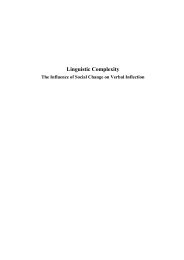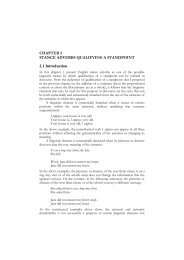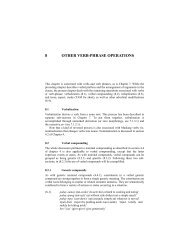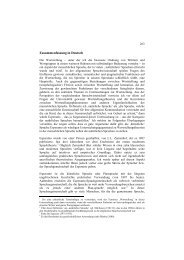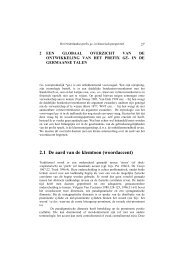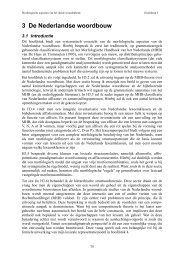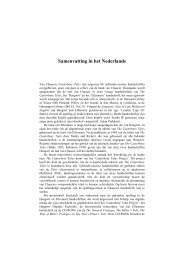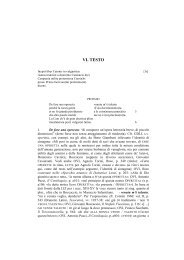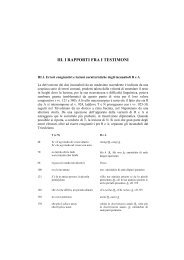Chapter 9 - LOT publications
Chapter 9 - LOT publications
Chapter 9 - LOT publications
Create successful ePaper yourself
Turn your PDF publications into a flip-book with our unique Google optimized e-Paper software.
Accounts of SLI in Afrikaans<br />
between overt and covert movement, which raises questions about its<br />
merit. 147<br />
A further criticism against the ATOM concerns the claim that one would<br />
not find utterances such as Her walks in the language of children with<br />
SLI, where subject-verb agreement and tense are indicated overtly, and<br />
the subject pronoun has accusative case. If the subject is taken to<br />
originate in the specifier position of the VP (or νP) and there is no TP<br />
present in the derivation, then the subject cannot move to the TP. If the<br />
subject does not move, one would expect DPs with any case to occur in<br />
the subject position of the sentence, because nominal expressions (for<br />
example, pronouns in English) are assumed to be retrieved from the<br />
lexicon with their case. Because there is no TP to check whether the case<br />
of the DP occurring in the subject position is, in fact, the correct case,<br />
such DPs can occur in what Wexler calls the “default” case, which is<br />
taken to be accusative for English. Because the case feature of the DP<br />
can receive a phonetic interpretation, 148 it follows that the occurrence of<br />
a DP with the incorrect, accusative case will not cause the derivation to<br />
crash at PF. In fact, examples such as Her walks do occur relatively<br />
frequently in the language of children with SLI (cf. Pine, Rowland,<br />
Lieven, and Theakston 2002).<br />
Despite the above criticisms, 149 and although not explicitly stated as such<br />
by Rice, Wexler, and colleagues, the ATOM – interpreted within a<br />
147 Also see the comments in section 3.4.3 on the overt-covert distinction possibly<br />
becoming a defunct one (cf. Hornstein et al. 2005:312).<br />
148 It could, of course, also be that the subject does carry the correct abstract case<br />
(NOM), but that this case is given the incorrect sound form, i.e., that an error occurs<br />
with the mapping of the morphological information onto the phonological form.<br />
149 I also take note of (i) the criticism by Rispoli (1999, 2002, 2005) against the ATOM;<br />
(ii) Charest and Leonard’s (2004) indication that the proposals of the ATOM need to<br />
be altered in order to account for their empirical findings; (iii) Joseph, Pine, and Conti-<br />
Ramsden’s (2002) and Pine, Rowland, Lieven, and Theakston’s (2002) finding that there<br />
are relatively frequent exceptions to the predictions of the ATOM; and (iv) Pine et al.’s<br />
(2002:273) comment that the range of situations in which the predictions of the ATOM<br />
can be tested is limited. Pine et al. (2004: 913) word the latter criticism more strongly:<br />
“… the ATOM derives much of its power from the fact that it is actually extremely<br />
difficult to test”. A related criticism is that the “invisibility” of agreement (and<br />
subsequent assignment of nominative in the case of [-tense, +agr]) is unfalsifiable,<br />
which could lead to the whole proposal being seen as somewhat stipulative. I<br />
furthermore take note of Lin’s (2006) suggestion that an alternative account – one on<br />
248



